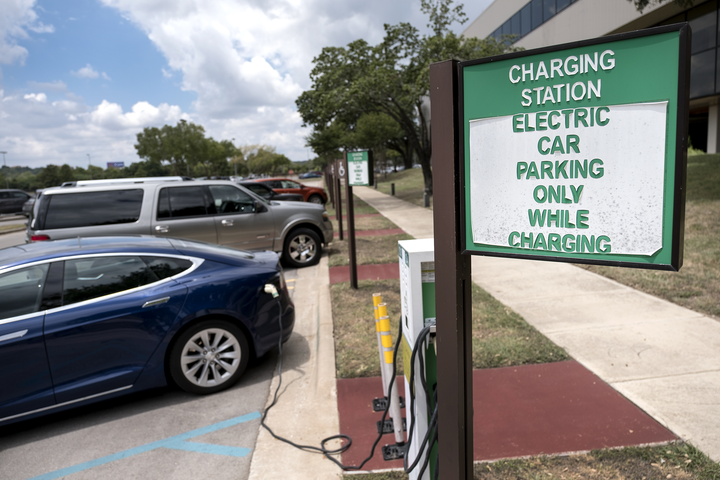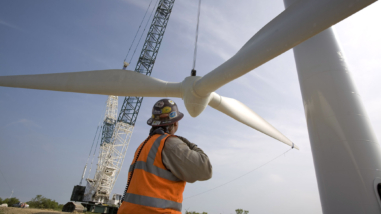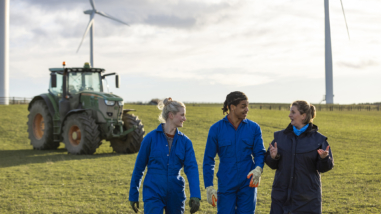Can innovative work be achieved by a program officer in a philanthropic organization? I remember asking this question eight years ago when I joined the Hewlett Foundation. Since then, I’ve learned that program staff at philanthropies get to focus on some of the world’s biggest problems and have the advantage of using their institution’s many resources to craft the best strategies to address them and to lever innovation.
Here at Hewlett, I’ve been privileged to work on the foundation’s climate change program – specifically working to solve climate change by reducing emissions from the transportation of people and goods. Through years of research, analysis, and collaboration with nongovernmental organizations (NGOs), government, industry, and academia alike, we’ve established a two-part strategy to reduce and eliminate carbon emissions from the transportation sector:
- Decarbonize fuels used by cars, ships, trains, and planes; and
- Optimize the efficiency of the overall transport system – that is, moving more people and more goods with fewer resources and fewer vehicles, producing significantly fewer carbon emissions
And while this two-pronged approach itself hasn’t changed much in the last eight years, what has changed dramatically is the rate at which innovation has transformed the landscape.
For example, in just eight years, many cities around the world have gone from a small set of transportation options to a variety of transportation choices – aided by information technology improvements and the extensive use of smart phones. It’s hard to imagine that ride sharing companies such as Uber, Lyft, Didi, and Ola didn’t even exist in 2010!
Bike-share programs have also become a way of life in many cities – first with physical docks, and now with the invention of dockless and electric (or pedal assist) bikes. Companies like Ofo, Jump, and Mobike have existed for only a couple of years, yet they have revolutionized urban transportation, particularly in crowded metropolises like New York, Mexico City, Washington D.C., Beijing, Shanghai, San Francisco, and many others.
The emergence of ride- and bike-sharing and other innovations in mobility were made possible by entrepreneurs seizing an opportunity and forward-looking policy and leadership from local governments. One of our grantees in Mexico, the Institute for Transportation and Development Policy, supported officials in Mexico City to implement Ecobici. Launched in 2013, it is the largest bike-sharing system in Latin America, with over 6,000 bikes replacing many car trips through dense neighborhoods of the city. The same year, our grantee, the World Resources Institute in India, ran Rickshaw Challenge, the first accelerator for new mobility business for three-wheelers, which opened the door for many other improved first- and last-mile connection services in various cities in this country.
In the last eight years, we’ve also seen the dramatic rise of electric vehicles (EVs) in many countries, such as the United States, Norway, Germany, Japan, and China, and ambitious commitments by developing nations like India and Costa Rica. In fact, the most popular electric vehicles today – the Tesla S and Nissan Leaf – were launched and introduced within the past decade. There are now three million EVs in the world, and cities like Los Angeles, London, Shenzhen, and Bangalore have committed to all-electric public bus fleets, with more to come online in cities around the globe.
As a program officer, I was given the opportunity to pivot our strategy to go beyond fixing our current internal combustion engines, to pushing for the industrial transformation of zero emissions technologies. This rapid initial adoption and expansion of electric vehicles was made possible because of strong vision from leaders at national, state, and local governments, and because of sound policy – policies such as stringent vehicle emissions standards, zero-emission vehicles mandates, consumer purchase incentives, and industrial incentives. I worked with many partners in the field to support these policies, bring knowledge to every corner, overcome barriers to consumers, foster new industry allies, and bring an equity perspective locally and globally.
The Hewlett Foundation and our philanthropic partners contributed to the electric vehicle revolution by supporting policy development and policy advocacy. First, we supported California’s own pioneer EV efforts, supporting the goals of the Zero Emission Vehicle Program and funding innovative policy advocacy campaigns, such as the Charge Ahead California Campaign. Composed of a strong coalition of various organizations, such as Environment California, the Greenlining Institute, Natural Resource Defense Council, Coalition for Clean Air, and Communities for a Better Environment, the campaign was set up to achieve 1.5 million electric vehicles on the road by 2025, and to ensure policies had an equity component.
Philanthropy has also supported other countries in their own efforts. The most remarkable example is the New Energy Vehicle Mandate in China, one of the most ambitious countrywide policies for promoting electric vehicles in the world. Fully implemented by 2020, China will have 4.5 million EVs. This policy benefited from collaboration across the Pacific, and Hewlett’s grantees, such as the Energy Foundation China, played an important part by commissioning specific studies and providing technical assistance.
Despite the progress on electric-friendly initiatives, we still have a long way to go. Clean vehicles are still a small percentage (two) of vehicles sales, and we need to get to at least at 30 percent by 2030, and close to 80 percent adoption by 2050 to ensure transport plays its role in the decarbonization of our economy. The transportation sector is one of the largest contributors to carbon pollution and climate change; its share of emissions now constitutes 23 percent of the global share. Moreover, only a handful of countries in the Paris climate agreement – nine percent – proposed a transport sector emission reduction target. Given these challenges, Hewlett has highlighted the importance of the transportation sector and has recognized the need to start actions to achieve transformative changes by 2050. One key indicator is that the clean transportation grants budget went from $7 million in 2010 to about $25 million in 2018.
Eight years ago, no one could have imagined the revolutionary technological advances and innovation we have today. Yet these years will likely pale in comparison to the next eight as technology continues to develop. City landscapes will adapt along with waves of innovation, such as those created by autonomous vehicles, likely leading to a complete rewiring of streets and modes of transportation. I have seen the need to “ride the wave” of new developments, look around the corner, and make the case for new policy and new approaches to advocacy that enhance the new paradigm we are entering. I am confident that philanthropy will continue to provide space for experimentation and ensuring technology and policy bring low-carbon transformation for all.
I am excited for my successor and for the next great wave of transportation innovation that ushers in both progress and opportunity for people and our climate worldwide.




